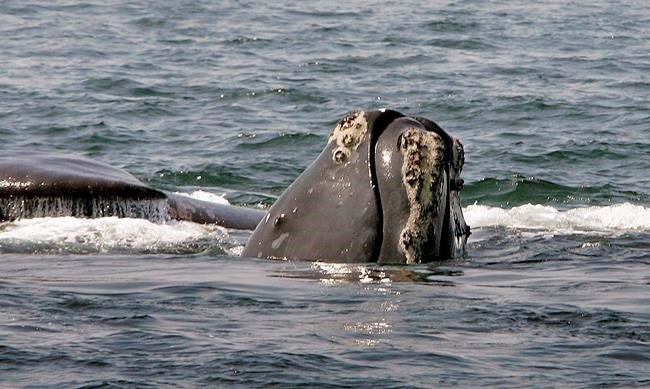HALIFAX — Canada has rolled out new measures to protect the critically endangered North Atlantic right whale, but federal officials insisted Thursday the rules won't lead to more of the Gulf of St. Lawrence and Bay of Fundy being closed to fishing.
The changes are needed because the whales' migration patterns in Canadian waters have become difficult to predict, Fisheries Minister Bernadette Jordan told a news conference on Parliament Hill.
"It's extremely important that we look after the North Atlantic right whale (because) it's an endangered species, partly due to human activity," Jordan said in an interview with The Canadian Press.
"We recognize that putting measures in place are going to be critical to maintaining that species."
Jordan said the new rules, which build on changes made since 2017, are aimed at reducing the main causes for the whales' population decline: ship strikes and entanglements with fishing gear.
Since June 2017, an unusually large number of right whales have died, reducing the population in the North Atlantic to about 400 animals and prompting warnings that the species is on its way to extinction.
In 2017, a total of 17 dead whales were found, 12 of them in Canadian waters. The following year, three dead whales were found in U.S. waters, and in 2019, nine dead whales were spotted in Canadian waters, and one in the United States.
That's a total of 30 dead whales in the past three years — 21 in Canada and nine in the United States.
Jordan said the new regulations were drafted with the input of the fishing industry, Indigenous groups, scientists and environmental groups.
Fishermen had complained some of the earlier measures were too restrictive.
"As we go forward, we are talking to the industry, talking to the fishers and finding out what's working, what's not," Jordan said. "Everything we're doing is in collaboration with them every step of the way."
Shannon Arnold, senior marine co-ordinator with the Halifax-based Ecology Action Centre, said the new measures are a strong start, but the group would like to see a better emergency plan in place.
"We want to make sure the government is ready to respond quickly should the announced measures fail," Arnold said.
With less than 100 breeding females left among the right whales, time is running out, she said: "If the recent trajectory continues, right whales will be functionally extinct in 20 years."
To prevent entanglements, Fisheries and Oceans Canada will use a new, dynamic system for fishing closures when whales are spotted or heard in the Gulf of St. Lawrence and the Bay of Fundy.
Unlike the static, season-long closures imposed in the past, fisheries officials will now declare closures in areas where whales are detected more than once in 15 days. Those areas, which will each measure 2,000 square kilometres, will remain closed to fishing until Nov. 15.
"What we're doing is actually tracking where the whales are, and then we will close it almost in a grid around the whale as it moves, so that we're not closing off a full area," Jordan said.
"That's something that's going to be extremely important to our fish harvesters, because they have more ability to know where things are going to be, instead of closing off one big area."
As well, the department confirmed Thursday it will expand the use of this type of closure into the Bay of Fundy, in response to a larger number of right whales returning to the bay last year.
Another new measure calls for improved marking of fishing gear to help officials determine where entanglements have taken place.
The minister said the changes announced Thursday are partially aimed at alleviating concerns in the United States, where some environmental groups have called for a ban on Canadian snow crab imports to pressure Canada to do more to save the whales.
"This isn't only about protecting the whales .... It is also about making sure we can maintain the export markets to the U.S., because the U.S. has made it clear we have to do everything we can to protect the whales," Jordan said.
Meanwhile, Transport Canada says vessels longer than 13 metres will be required to comply with new rules to reduce ship strikes, including speed limits for a vast area off northeastern New Brunswick and south of Anticosti Island.
In a large, newly designated area that stretches from New Brunswick's Chaleur Bay to Quebec's Iles-de-la-Madeleine, large vessels will be required to avoid the area or reduce their speed to eight knots. However, the exact size of this area and the timing for the speed restriction has yet to be determined.
Cargo ships typically cruise at speeds of between 12 and 25 knots on the open ocean, though speeds around 20 knots or less are more common.
A new voluntary speed limit of 10 knots will be imposed in the Cabot Strait between April 28 and June 15, though it remains unclear how this rule will affect the ferry service that links Nova Scotia with Newfoundland. The voluntary limit will resume between Oct. 1 to Nov. 15 as the whales move out of the gulf.
Traditional aerial surveillance using fixed-wing aircraft will resume this year, and officials confirmed Thursday that aerial drones and so-called underwater acoustic gliders will also be used as part of regular monitoring.
The conservation group Oceana Canada called Ottawa's actions encouraging but said more needs to be done. "Fishing zone closures and speed requirements for vessels are triggered based on whale sightings, so we strongly urge the government to step up surveillance," campaign director Kim Elmslie said in a statement.
This report by The Canadian Press was first published Feb. 27, 2020.
— With files from Kevin Bissett in Fredericton.
Michael MacDonald , The Canadian Press



